
Expert Verified, Online, Free.

You have a server named Server1 that runs Windows Server 2012 R2. Server1 has the Hyper-V server role installed.
An iSCSI SAN is available on the network.
Server1 hosts four virtual machines named VM1, VM2, VM3, and VM4.
You create a LUN on the SAN to host the virtual hard drive files for the virtual machines.
You need to create a 3-TB virtual hard disk for VM1 on the LUN. The solution must prevent VM1 from being paused if the LUN runs out of disk space.
Which type of virtual hard disk should you create on the LUN?
Correct Answer:
B
🗳️
The virtual disk needs to be a VHDX file since it is going to be over 2TB in size and it must be fixed-size so that the space is already taken on the server (that way the server does not run out of space as the volume grows) even if the actual virtual disk does not yet hold that amount of data.
Your network contains an Active Directory domain named adatum.com. The domain contains a member server named Host1. Host1 runs Windows Server 2012
R2 and has the Hyper-V server role installed.
Host1 hosts two virtual machines named VM5 and VM6. Both virtual machines connect to a virtual switch named Virtual1.
On VM5, you install a network monitoring application named Monitor1.
You need to capture all of the inbound and outbound traffic to VM6 by using Monitor1.
Which two commands should you run from Windows PowerShell? (Each correct answer presents part of the solution. Choose two.)
Correct Answer:
CE
🗳️
- PortMirroring specifies the port mirroring mode for the network adapter. This can be set to None, Source, and Destination.
✑ If set to Source, a copy of every network packet it sends or receives is forwarded to a virtual network adapter configured to receive the packets.
✑ If set to Destination, it receives copied packets from the source virtual network adapter.
In this scenario, VM5 is the destination which must receive a copy of the network packets from VM6, which s the source.
Reference: http://technet.microsoft.com/en-us/library/hh848457.aspx
You have a Hyper-V host named Server1 that runs Windows Server 2012 R2. Server1 has the virtual switches listed in the following table.
You create a virtual machine named VM1.VM1 has two network adapters. One network adapter connects to vSwitch1. The other network adapter connects to vSwitch2.You configure NIC teaming on VM1.
You need to ensure that if a physical NIC fails on Server1, VM1 remains connected to the network.
What should you do on Server1?
Correct Answer:
A
🗳️
Your network contains two Hyper-V hosts that run Windows Server 2012 R2. The Hyper-V hosts contain several virtual machines that run Windows Server 2012
R2.
You install the Network Load Balancing feature on the virtual machines.
You need to configure the virtual machines to support Network Load Balancing (NLB).
Which virtual machine settings should you configure?
Correct Answer:
D
🗳️
http://social.technet.microsoft.com/Forums/windowsserver/en-US/5b3a0a9d-26a2-49ba-bbbe- 29d11fcbb7ce/nlb-on-hyperv?forum=winserverhyperv
For NLB to be configured you need to enable MAC address spoofing.
You have a server named Server1 that runs Windows Server 2012 R2. Server1 has the Hyper-V server role installed. Server1 is connected to two Fibre Channel
SANs and is configured as shown in the following table.
You have a virtual machine named VM1.
You need to configure VM1 to connect to SAN1.
What should you do first?
Correct Answer:
B
🗳️
You need your virtualized workloads to connect easily and reliably to your existing storage arrays.
Windows Server 2012 provides Fibre Channel ports within the guest operating system, which allows you to connect to Fibre Channel directly from within virtual machines. This feature protects your investments in Fibre Channel, enables you to virtualize workloads that use direct access to Fibre Channel storage, allows you to cluster guest operating systems over Fibre Channel, and provides an important new storage option for servers hosted in your virtualization infrastructure.
With this Hyper-V virtual Fibre Channel feature, you can connect to Fibre Channel storage from within a virtual machine. This allows you to use your existing Fibre
Channel investments to support virtualized workloads.
Support for Fibre Channel in Hyper-V guests also includes support for many related features, such as virtual SANs, live migration, and MPIO.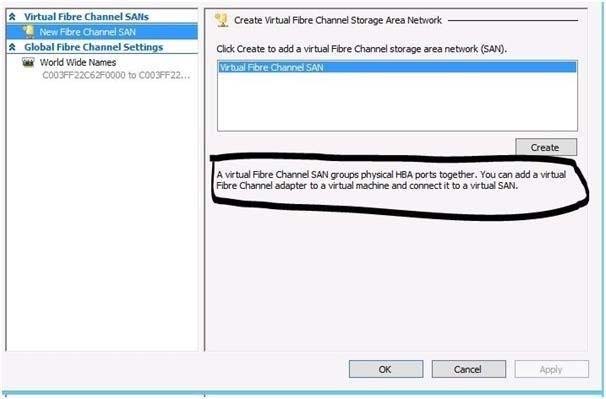
Your network contains an Active Directory domain named contoso.com. The domain contains a server named Server1. Server1 runs Windows Server 2012 R2 and has the Hyper-V server role installed.
On Server1, you create and start a virtual machine named VM1. VM1 is configured as shown in the following table.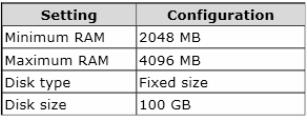
You need to recommend a solution to minimize the amount of disk space used for the checkpoint of VM1.
What should you do before you create the checkpoint?
Correct Answer:
C
🗳️
Changing between a fixed and dynamic disk type does not alter the size of a SNAPSHOT much at all.
However, since a snapshot is a record of a VMs state at the exact time that the snapshot was taken, shutting down the VM before taking the snapshot prevents the snapshot from having to contain all of the data in RAM (as there is no data in memory when a machine is powered down).
The question states that the solution should minimize the amount of disk space used for the checkpoint of VM1. If the checkpoint is taken while VM1 is running, there will be two attritional files present at the checkpoint location; a .VSV with VM1 saved state files and a .BIN file which contains VM1s memory contents. If, however, VM1 is shut down first, these files will not be created, thus saving disk space.
In order to convert Disk1.vhd to a dynamically expanding disk, VM1 still have to be shut down.
HOTSPOT -
You have a Hyper-V host named Hyperv1 that runs Windows Server 2012 R2. Hyperv1 hosts a virtual machine named Server1. Server1 uses a disk named
Server1.vhdx that is stored locally on Hyperv1.
You stop Server1, and then you move Server1.vhdx to an iSCSI target that is located on another server.
You need to configure Server1 to meet the following requirements:
✑ Ensure that Server1 can start by using Server1.vhdx.
✑ Prevent Server1.vhdx from consuming more than 500 IOPS on the iSCSI target.
Which two objects should you configure? To answer, select the appropriate two objects in the answer area.
Hot Area:
Correct Answer:
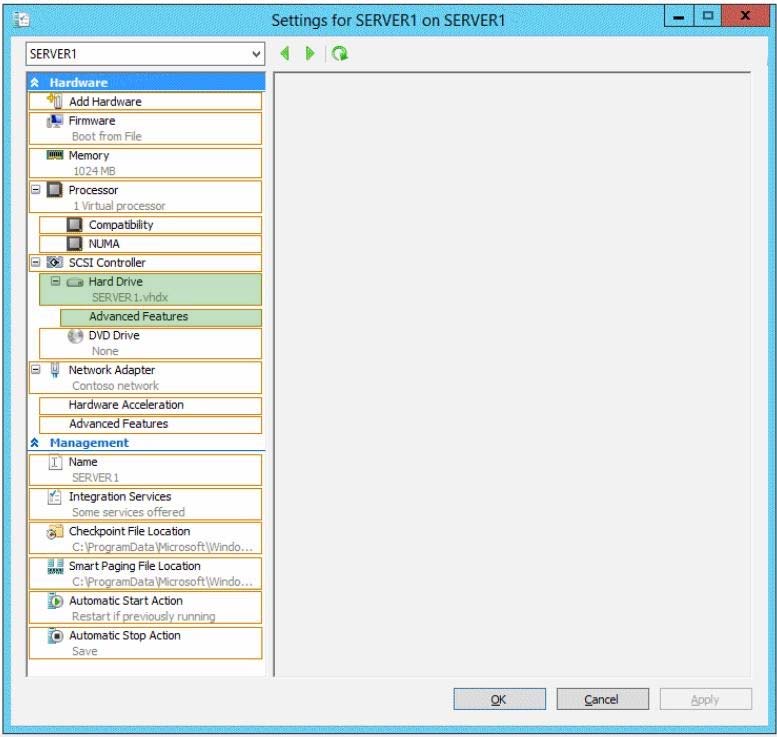
You have a print server named Server1 that runs Windows Server 2012 R2.
You discover that when there are many pending print jobs, the system drive occasionally runs out of free space.
You add a new hard disk to Server1.You create a new NTFS volume.
You need to prevent the print jobs from consuming disk space on the system volume.
What should you modify?
Correct Answer:
C
🗳️
Windows spools print jobs by default to the following directory as they are processed:
%SystemRoot%\SYSTEM32\SPOOL\PRINTERS.
It is possible for the administrator of a Windows print server to manually instruct Windows the location for placing the spool files, if for example there is a concern for disk space.
HOTSPOT -
A printer named Printer1 is configured as shown in the exhibit. (Click the Exhibit button.)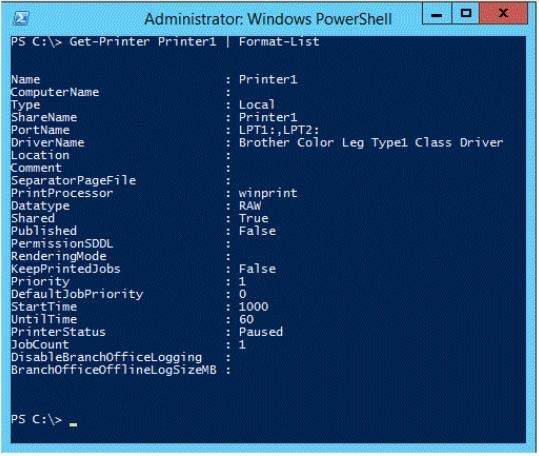
To answer, complete each statement according to the information presented in the exhibit. Each correct selection is worth one point.
Hot Area: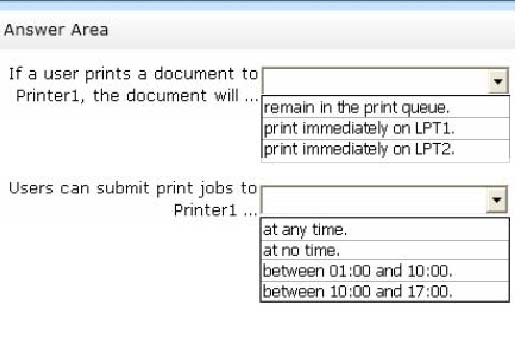
Correct Answer:
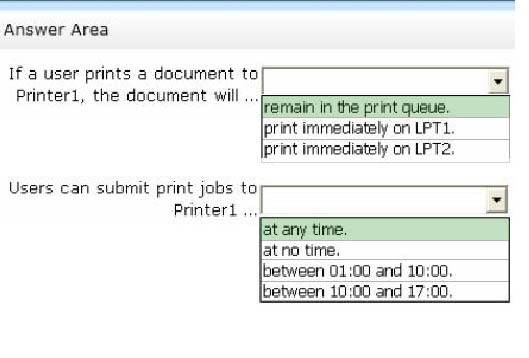
* The printer is paused.
* Jobs can always be permitted (even if the printer is paused, or printer not started).
Note:
StartTime -
Date and time that a printer can start to print a job if the printer is limited to print at specific times. This value is expressed as the time elapsed since 12:00 AM
GMT (Greenwich Mean Time).
This is sort of a trick question. As it stands, when the PowerShell script was executed, the printer is in "Paused" status, so any submitted job will go to the queue and remain there until the status is "Available". As for the ability to submit a job, a user can SUBMIT the job at any time. If it is outside of the printer's availability range, it will simply remain in the queue until the printer's start time is reached.
HOTSPOT -
Your network contains an Active Directory domain named contoso.com. The domain contains a print server named Server1 that runs Windows Server 2012 R2.
You share several printers on Server1.
You need to ensure that you can view the printer objects associated to Server1 in Active Directory Users and Computers.
Which option should you select?
To answer, select the appropriate option in the answer area.
Hot Area: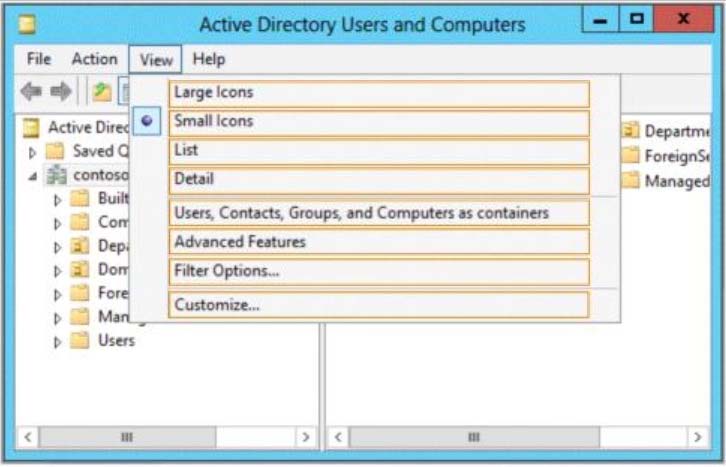
Correct Answer:
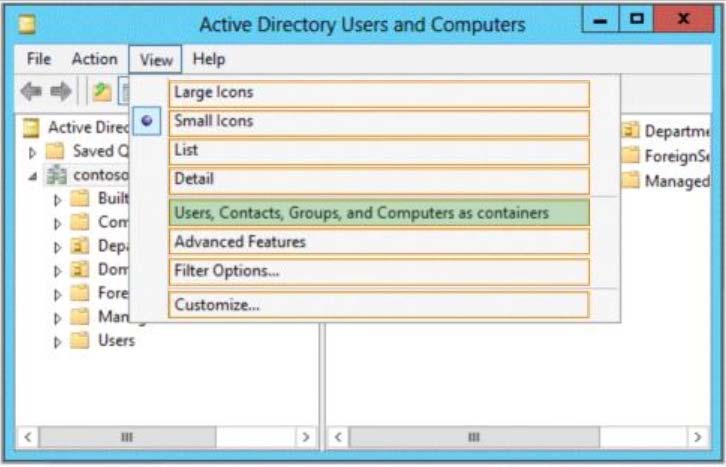
You can view printer objects in Active Directory by clicking Users, Groups, and Computers as containers from the View menu in the Active Directory Users and
Computers snap-in. By default, printer objects are created under the machine object in which they are shared. After you turn on the Users, Groups, and
Computers as containers option, you can see printers by expanding the printer's host computer.
Reference: http://support.microsoft.com/kb/235925